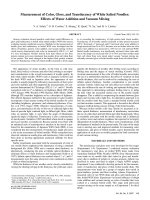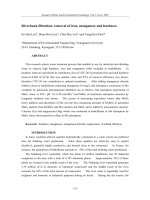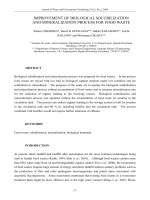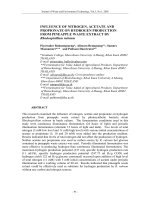Microbiology of Fruit Juice and Beverages
Bạn đang xem bản rút gọn của tài liệu. Xem và tải ngay bản đầy đủ của tài liệu tại đây (4 MB, 29 trang )
5
Microbiology of Fruit
Juice and Beverages
Purnendu C. Vasavada
CONTENTS
Introduction
Microbial Spoilage of Fruit and Fruit Juice and Beverages
Bacteria
Yeasts and Molds
Indicator Bacteria and Pathogenic Organisms
Protozoa
Pathogenic Yeasts
Viruses
Mycotoxins
Emerging Pathogens and Outbreaks of Illness
Early Outbreaks
Outbreaks in the 1990s
Illness from Other Potential Food Safety Hazards
Ensuring Safety of Juice: Strategy and Control
GMP and Best Practices for Juice Processors
Model HACCP
Summary
Acknowledgment
References
INTRODUCTION
Fruit juices and fruit-based beverages are popular products appealing to a
broad demographic group, particularly children and young adults, and rep-
resent an important segment of the domestic and international market. Juices
are the aqueous liquids expressed or otherwise extracted usually from one
or more fruits or vegetables, purees of the edible portion of one or more
fruits or vegetables, or any concentrates of such liquids or purees. Fruit juice
may be an ingredient in beverages. A wide variety of juice and beverage
TX110_book Page 95 Tuesday, May 6, 2003 9:21 AM
© 2003 by CRC Press LLC
products including juice (100% juice), juice blends (combinations of several
juices), juice drinks (not 100% juice), and ßavored beverages in a variety of
types, including fresh, refrigerated, shelf stable, frozen concentrate, nonfro-
zen concentrate, sports drinks, energy drinks, etc., are currently available on
the U.S. market (see Table 5.1).
1–5
Consumption of fruit juice and beverages
in the U.S. has increased steadily during the past two decades. In 1998, U.S.
consumers drank an average of about 9 gallons of juice and about 6 gallons
of fruit beverages per year.
2
While consumption of milk, coffee, wine, beer,
and spirits has generally declined in recent years, consumption of juices,
beverages, soft drinks, sports drinks, and bottled water has increased.
6
In
1999, consumers drank an average of 15.5 gallons of bottled water, 55.9
gallons of soft drinks, and 2.3 gallons of sports drinks.
3
Per capita consump-
tion trends are summarized in Figure 5.1.
6,7
Fruit juices and beverages are important commodities in the global mar-
ket, providing ample opportunity for innovative, value added products to
meet consumer demand for convenience, nutrition, and health. Beverages
constituted a signiÞcant proportion (33–73%) of various health promoting
new products or product lines introduced in the U.S. in 2000 (see Table 5.2).
4
According to a recent industry report, the U.S. functional beverage market
generated revenues of $4.7 billion in 2000 and is expected to exceed $12
billion by 2007.
4
Fruit juices and beverages contain water, sugars, organic acids, vitamins, and
trace elements and provide an ideal environment for spoilage by microorganisms,
particularly yeasts, molds, and aciduric organisms. Pathogenic bacteria are usu-
TABLE 5.1
New Beverage Introductions
2001 2000 1999
Hot beverages
479 470 575
RTD juices/juice drinks
265 217 307
Concentrates/mixes
122 154 121
Energy/sports drinks
104 86 107
Carbonated soft drinks
82 68 94
RTD iced tea/coffee
43 102 80
Beer/cider
25 93 65
Water
50 65 65
Flavored alcoholic drinks
29 16 12
Total
1199 1271 1426
Source:
Adapted from Enright, A.,
Prepared Foods
, 170(4), 41–42, 2001; Roberts, W. and
Dornblaser, L.,
Prepared Foods,
171(4), 19–29. 2002.
TX110_book Page 96 Tuesday, May 6, 2003 9:21 AM
© 2003 by CRC Press LLC
FIGURE 5.1
U.S. per capita beverage consumption: 1972–1997. * = No bottled water data collected during this period. (Adapted from
Rowles, K., Processed apple products and marketing analysis: apple juice and cider, SP 2002–01, Cornell University, Ithaca, NY, 2001
and Putnam, J.J. and Allshouse, J.E., Food Consumption, Prices and Expenditure: 1970–1997, Food and Rural Economics Division,
USDA Economic Research Service, Statistical Bulletin No. 965, April 1999.)
1972-76 1977-81
1982-86
1987-91
1992-96 1997
60.0
50.0
40.0
30.0
20.0
10.0
0.0
Milk
Bottle Water
Coffee
Beer
Tea
Wine
Soft Drinks
Distilled Spirits
Fruit Juices
Gallons
32.8
7.5
28.1
6.5
1.7
1.9
20.6
30.0
28.1
26.8
34.4
23.6
7.2 6.9
2.1
2.02.0
26.4
26.8
35.6
24.1
7.0
7.9
4.0
2.3
1.8
25.9
26.5
45.2
23.7
7.0
7.8
7.1
2.1
1.5
24.7
22.7
8.1
8.7
10.5
50.7
22.4
1.8
1.3
24.0
23.5
7.4
9.2
13.1
22.0
2.0
1.2
53.0
*
TX110_book Page 97 Tuesday, May 6, 2003 9:21 AM
© 2003 by CRC Press LLC
ally not a problem in fruit juices and beverages. However, several outbreaks of
foodborne illness attributed to consumption of commercial, nonpasteurized
(unpasteurized or “fresh”) fruit juices and beverages have occurred in recent
years.
7–10
At least one outbreak involved a fatality.
11
These outbreaks, attributed
to emerging pathogens such as
Escherichia coli
O157:H7,
Salmonella,
and
Cryptosporidium parvum
, have caused concern among the consuming public.
While 98% of the juice sold in the U.S. is pasteurized or otherwise treated to
control the risk of pathogenic contamination, some 40 million gallons of juice
are not pasteurized, posing a risk of contamination with pathogenic bacteria.
Unpasteurized products cause 6000 cases of illness per year, according to esti-
mates from the U.S. Food and Drug Administration (FDA). To address the
problem of pathogenic contamination in fruit juice and beverages, the FDA
issued regulations, as an interim measure, requiring warning labels on juices that
are “fresh” or have not been processed to destroy pathogens that may be present.
13
The FDA also required implementation of the Hazard Analysis and Critical
Control Point (HACCP) system, which is designed to identify potential hazards
and “prevent, reduce, or eliminate” those hazards by using processes that achieve
a 5-log or 10,000-fold reduction in numbers of pathogens in the Þnished prod-
ucts.
12,14
This chapter reviews the microbiology of fruit juice and beverages in
the contexts of spoilage and safety of fruit juice and beverage production.
MICROBIAL SPOILAGE OF FRUIT AND FRUIT JUICE
AND BEVERAGES
B
ACTERIA
The most commonly encountered spoilage bacteria in fruit juices and soft
drinks include species of
Acetobacter, Alicyclobacillus, Bacillus, Clostridium,
TABLE 5.2
New Products Introduced in the U.S.
in 2000 Claiming Health Benefits
Health Condition Beverages (%)
Immune (62) 73
Heart health (59) 56
Diabetes (24) 33
Osteoporosis (23) 70
Cancer (4) 50
Source:
Adapted from O’Donnell, C.D.,
Prepared
Foods,
170(4), 50–51, 2001.
TX110_book Page 98 Tuesday, May 6, 2003 9:21 AM
© 2003 by CRC Press LLC
Gluconobacter, Lactobacillus, Leuconostoc, Saccharobacter, Zymomonas,
and
Zymobacter
.
15–23
(See Table 5.3.) Strictly aerobic, acidophilic bacteria such as
Acetobacter
and
Gluconobacter
(
Acetomonas
) have been known to cause
spoilage of fruit concentrates, apple cider, and soft drinks.
15
The lactic acid
bacteria,
Lactobacillus
and
Leuconostoc
spp., are also known to be associated
with spoilage of fruit juice including abnormal fermentation and gas produc-
tion, development of slime or ropiness, production of buttermilk-like off-
ßavor, and formation of cloudiness and turbidity.
22
They are among the most
signiÞcant microorganisms in processing citrus juices. Spore-forming organ-
isms (
Bacillus
and
Clostridium
spp.) are also known to cause spoilage in fruit
juice and beverages.
22
Spoilage of fruit juices by
Clostridium
spp. is charac-
terized by production of gas, a strong butyric odor, and increased acidity.
19
Recently,
Alicyclobacillus
, an acidophilic, heat-resistant, spore-forming
organism, has caused concern in the fruit juice industry.
20,24–26
The organism
was Þrst reported in 1982 as causing spoilage in apple juice in Germany.
24
The characteristic spoilage involves the formation of a phenolic or antiseptic
odor with or without cloudiness and generally without gas production.
17,19
TABLE 5.3
Bacteria Related to Spoilage in Fruit Juices and Soft Drinks
Microorganisms Ace Food Products Effects
Acetobacter,
Gluconobacter
Apple cider, soft drinks,
fruit juice concentrate
Oxidation of ethanol,
fermentation, turbidity
Lactobacillus, Leuconostoc
Orange juice concentrate,
soft drinks
Sour or off-taste, buttermilk
off-ßavor, gummy slime or
“ropiness,” acetic acid, gas
(CO
2
), ethanol
Alicyclobacillus
acidoterrestris
Apple-cranberry beverage,
apple juice, orange juice
concentrate, mixed fruit
beverages
Phenolic or antiseptic odor
or off-ßavor with or
without light sediment
Bacillus coagulans, B.
macerans, B. polymyxa, B.
licheniformis, B. subtilis
Tomato juice, soft drinks Flat sour spoilage
Clostridium pasteurianum,
C. butyricum
Tomato juice, soft drinks,
fruit juice
Increased acidity, gas,
strong butyric odor
Zymomonas,
Saccharobacter
fermentatus, Zymobacter
Apple cider, agave leaf
juice
Ethanol production
Source:
From Vasavada, P.C. and Heperkan, D.,
Food Safety Magazine
, 8(1):
8,10,13,46–47, 2002. With permission.
TX110_book Page 99 Tuesday, May 6, 2003 9:21 AM
© 2003 by CRC Press LLC
The characteristic off-ßavor associated with
Alicyclobacillus
spoilage
involves guaiacol 2,6-dibromophenol and 2-methoxyphenol.
17,18,26
However,
in a study of apple juice inoculated with
A. acidoterrestris
, the guaiacol
content in apple juice did not always correlate with the number of cells.
27
Alicyclobacillus
spoilage occurs seasonally, typically in the spring or summer,
and occurs most commonly in apple juice and orange juice.
20,25,28
Contami-
nation of fruit juices by
Alicyclobacillus
occurs via soil during the harvest.
28
Wisse and Parrish
27
found acidophilic, heat-resistant bacilli in the environment
at one citrus processing plant. Strains of acidophilic, heat-resistant bacilli
were detected in seven of 18 soil samples from orange groves, on surfaces
of unwashed oranges at eight of 10 processing plants, on surfaces of washed
oranges at six of nine processing plants, and in condensate water used to wash
fruit at six of seven test facilities.
28
Two pear juice concentrates from 210 l
drums, as well as retail packages of pear juice and orange juice nectar, also
contained acidophilic, heat-resistant bacilli.
28
The researchers suggested that
because fruit surfaces may be continuously contaminated with spores from
the condensate wash water, the extracted juice could very well contain spores,
and theoretically, contaminate the evaporator. Another study in 1999 reported
Þnding
Alicyclobacillus
in 11/75 (14.7%) samples of concentrated orange
juice.
21
In 1998, Splittstoesser et al.
25
reported that white grape and tomato
juices also are susceptible to spoilage by this bacterium. In a survey of the
food industry, 35% of respondents had experienced spoilage of their products
due to acidophilic spore-forming bacteria. In addition to apple and orange
juices, this organism also has been found in apple-grape-raspberry and apple-
pear juice blend beverages.
20,28
The genus
Alicyclobacillus
is comprised of three species:
A. acidocal-
darius, A. acidoterrestris,
and
A. cycloheptanicus
.
Alicyclobacillus
spores
are very heat resistant, with reported D-values ranging from 14 to 54 minutes
at 90–91ûC and z-values between 6 and 10ûC. These bacteria can easily
survive the typical heat treatment normally applied to pasteurize fruit
juices.
21,29
The elevated heat resistance shown by
Alicyclobacillus
spores
represents a potential risk for the deterioration of pasteurized, ultra-high
temperature, or hot-Þll orange juices when stored without refrigeration
because the spores of this organism are able to germinate and grow at
temperatures below 35ûC. Growth of
Alicyclobacillus
was obtained over a
pH range of 3.0 to 6.0 in an agar medium.
17
However, growth was inhibited
when the ethanol concentration exceeded 6% and the sugar content exceeded
18 Brix.
16
Raising the sugar content of juices appears to increase the heat
resistance of the bacteria. These results indicate that it would be more difÞcult
to destroy the spores in a juice concentrate, as compared with a single-
strength juice. Additional research has indicated that the complete elimina-
tion of these heat-resistant acidophilic bacteria from fruit juices would be
TX110_book Page 100 Tuesday, May 6, 2003 9:21 AM
© 2003 by CRC Press LLC
difÞcult, but that improvement of fruit cleaning operations and condensate
water systems may reduce the incidence of thermoacidophilic bacilli in fruit
juices.
28
Rinsing the sanitary surfaces of equipment and evaporators with
condensate water containing spores of heat-resistant bacilli may contaminate
the juice entering the evaporator or the Þnal product. The study also sug-
gested that heat treatment in the evaporator was not sufÞcient to kill the
spores of these bacteria.
Y
EASTS
AND
M
OLDS
Yeasts and molds are major causes of spoilage of fruit juices and beverages.
Yeasts predominate in the spoilage ßora of fruit products because of their
high acid tolerance and the ability of many of them to grow anaerobically.
Reportedly, 40% of commercial fruit juices are contaminated with
yeasts.
22,31–36
A high level of yeast contamination in fruit juices and soft
drinks may be indicative of poor plant hygiene. Most spoilage yeasts are
highly fermentative, forming ethanol and CO
2
from sugar, causing split
cans and cartons, and explosions in glass or plastic bottles.
22
Pitt and
Hocking
31
have listed yeasts predominantly responsible for spoilage of fruit
juice, concentrates, and soft drinks including
Brettanomyces intermedius,
Saccharomyces bailii, S. bisphorus, S. cerevisiae, S. rouxii, Schizosaccha-
romyces pombe,
and
Torulopsis holmii.
Parish and Higgins
35
isolated sev-
eral species of yeast, including
Candida maltosa, Candida sake, Hanse-
niaspora guilliermondii, Hanseniaspora
sp
., Pichia membranaefaciens,
Saccharomyces cerevisiae,
and
Schwanniomyces occidentalis,
from com-
mercially produced unpasteurized orange juice. Other common yeasts
include
Dekkera bruxellensis, Saccharomyces bayanus, Torulaspora del-
bruckii, Zygosaccharomyces microellipsodes
, and
Dekkera naardenensis
(Brettanomyces naardenensis).
22,31,32
Mold contamination is generally not a problem in freshly squeezed
orange juice unless moldy or decomposed fruit is used.
36,38
However, aer-
obic molds can contaminate the product, grow near the surface, and cause
spoilage of fruits and soft drinks. Mold growth can result in an off-ßavor
or odor that may be described as “stale” or “old,”
36
development of a
mycelial mat,
31
reduction in sugar content,
36
and mycotoxin production in
fruit juices and soft drinks.
39,40
Heat-resistant genera of molds causing
spoilage of soft drinks and fruit juices include Byssochlamys, Paecilomy-
ces, Neosartorya, Talaromyces, and some species of Eupenicillium.
23,33,37
(See Table 5.4.) Up to 27% of samples of mango and tomato juice were
reported to contain heat-resistant molds.
37
Parish and Higgins
35
isolated
genera of Aureobasidium, Cladosporium, and Penicillium from pasteurized
orange juice.
TX110_book Page 101 Tuesday, May 6, 2003 9:21 AM
© 2003 by CRC Press LLC
I
NDICATOR
B
ACTERIA
AND
P
ATHOGENIC
O
RGANISMS
Coliforms, E. coli, and enterococci have been isolated from citrus and other
fruit products, including “fresh” (unpasteurized) juice. The coliforms may
be part of the normal ßora of processing plants and are not necessarily
indicative of unhygienic production and processing practices. However,
TABLE 5.4
Heat-Resistant Molds Isolated from Fruit Juices,
Concentrates, and Soft Drinks
Product Heat-Resistant Mold
Apple juice Byssochlamys fulva
Paecilomyces fulvus
Talaromyces macrosporus
Byssochlamys nivea
Neosartorya Þscheri
Eupenicillium brefaldianum
Talaromyces macrosporus
Phialophora sp.
Apple concentrate Paecilomyces fulvus
Apricot juice Byssochlamys nivea
Berry juice Byssochlamys fulva
Eupenicillium lapidosum
Grape juice Byssochlamys fulva
Paecilomyces fulvus
Talaromyces macrosporus
Byssochlamys nivea
Monascus purpureus
Neosartorya Þscheri
Thermoascus aurannthiacum
Grape concentrate Byssochlamys fulva
Byssochlamys nivea
Pineapple juice Talaromyces macrosporus
Pineapple concentrate Byssochlamys fulva
Neosartorya Þscheri
Talaromyces macrosporus
Fruit punch Byssochlamys fulva
Fruit punch concentrates Byssochlamys nivea
Byssochlamys fulva
Mango concentrate Neosartorya Þscheri
Source: From Vasavada, P.C. and Heperkan, D., Food Safety Mag-
azine, 8(1): 8,10,13,46–47, 2002. With permission.
TX110_book Page 102 Tuesday, May 6, 2003 9:21 AM
© 2003 by CRC Press LLC
the presence of E. coli may indicate fecal contamination of the fruit surface
or unsanitary handling, storage, and processing of fruit. Many pathogens
readily adapt to the high-acid, low-pH juice environment and pose a public
health threat.
41,42
They do not grow under acidic conditions but may survive
for extended periods of time at refrigeration temperatures. Several oppor-
tunistic bacteria and yeasts such as Klebsiella, Enterobacter, Candida, and
Torulopsis are often found in fruit juices. While they are very unlikely to
affect healthy individuals, they are of concern to the at-risk population of
immunocompromised patients, including those undergoing chemotherapy
and radiation treatments.
42
P
ROTOZOA
Cryptosporidium parvum is a signiÞcant cause of severe gastrointestinal
disease in both immunocompetent and immunodeÞcient individuals. In 1993
and 1996, apple cider was associated with cryptosporidiosis outbreaks in
which 191 people were affected (Table 5.5). It was believed that apples used
for cider were contaminated when they fell on ground grazed by cattle
shedding C. parvum oocysts or when they were washed with contaminated
well water.
43,44
Deng and Cliver
45
suggested that heating for 10 to 20 sec at
70 and 71.7ûC caused oocyst killing of at least 4.1 log, whereas oocyst
inactivation after pasteurization for 5 sec at either temperature was 3.0 and
4.8 log, respectively. They concluded that current practices of ßash pasteur-
ization in the juice industry are sufÞcient to inactivate contaminant oocysts.
Deng and Cliver
46
compared various methods for the detection of C. parvum
oocysts from apple juice and found that the highest sensitivity, 10 to 30
oocysts per 100 ml of apple juice, was achieved by direct immunoßuores-
cence assay (DIFA) followed by immunomagnetic capture (IC) of oocysts
from samples concentrated by the ßotation method and acid fast staining
(AFS), and the polymerase chain reaction (PCR).
P
ATHOGENIC
Y
EASTS
In addition to pathogenic bacteria, several new pathogenic yeasts, including
Candida famata (Debaryomyces hansenii), Candida guillermondii (Pichia
guillermondii), Candida krusei (Issatchenkia orientalis), Candida parapsi-
losis, and Saccharomyces cerevisiae can cause spoilage of fruit juices and
beverages. These new pathogens are very unlikely to affect healthy individ-
uals but are of concern in immunocompromised patients.
23
V
IRUSES
Viruses are not very common in fruit juices and products. However, contam-
ination by hepatitis A and Norwalk-like virus (small round structured viruses,
TX110_book Page 103 Tuesday, May 6, 2003 9:21 AM
© 2003 by CRC Press LLC
SRSVs) has been reported.
23,44
In April 2000, 24 people attending a confer-
ence in Atlanta suffered from viral gastroenteritis associated with fresh
squeezed unpasteurized fruit smoothies. Norwalk-like virus was detected in
three stool samples from patients suffering from the illness.
47
TABLE 5.5
Microorganisms Related to Foodborne Illness in Fruit Juices
Microorganisms Food Product
No. of
Cases Year/Country Ref.
Bacillus cereus Orange juice 85 1994/U.S. 44
Cryptosporidium parvum Apple cider
(unpasteurized)
31 1996/U.S. 44
Cryptosporidium parvum Apple cider
(unpasteurized)
160 1993/U.S. 43, 44
Cryptosporidium parvum Apple juice NS ? 66
E. coli O157:H7 Apple cider 9 1999/U.S. 44
E. coli O157:H7 Apple cider 13 1991/U.S. 63
E. coli O157:H7 Apple cider 14 1980/Canada 44
E. coli O157:H7 Apple juice
(unpasteurized)
70 1996/U.S. and
Canada
44, 63
E. coli O157:H7 Apple juice
(unpasteurized)
6 1996/U.S. 13, 44
E. coli O157:H7 Apple juice 10 1996/U.S. 44
E. coli O134 Orange juice NS ? 65
Salmonella anatum Orange juice 4 1999/U.S. 44
S. enteritidis Orange juice 74 2000/U.S. 67
S. hartford
S. gaminara
S. rubislaw
Orange juice 62 1995/U.S. 44
S. muenchen Orange juice 220 1999/U.S. and
Canada
44
S. typhi Frozen mamey
(often used to
make juice)
16 1999/U.S. 44
S. typhi Orange juice 44 1989/U.S. 44
S. typhimurium Apple cider
Orange juice
~300
427
1974/U.S.
1999/Australia
44
64
Norwalk-like virus Fruit smoothies 24 2000/U.S. 44
Small round structured
viruses (SRSVs)
Orange juice 3000 ? 23
NS = not speciÞed
TX110_book Page 104 Tuesday, May 6, 2003 9:21 AM
© 2003 by CRC Press LLC
M
YCOTOXINS
Several species of molds are capable of producing different mycotoxins in
fruit juices. Mycotoxins, particularly patulin, represent a potent food safety
hazard in fruit juice and beverages. Some molds, e.g., Penicillium expansum,
P. griseofulvum, P. roqueforti var. carneum, P. funiculosum, P. claviforme,
P. granulatum,
39,40,48,49
and Byssochlamys spp.,
39,40
produce patulin in apple
juice, while others such as Neosartorya produce fumitremorgins, terrein,
verruculogen, and Þscherin. Byssochlamys species also produce byssotoxin
A and byssochlamic acid.
40
Mycotoxin production in fruit juice is a global problem. Patulin produc-
tion in fruit juice has been reported in several countries: 65% of 113 samples
of apple juice in Australia,
50
44% of 215 samples of apple juice concentrates
in Turkey,
51,52
3% of 111 samples of processed apple and grape juice in
Brazil, and 23% of 40 apple juice samples in the U.S. tested positive for
patulin.
53
Patulin in apple juice may be eliminated by fermentation of the
apple juice to cider or addition of ascorbic acid.
53
Other mycotoxins produced
in fruit juice by molds include ochratoxin A, citrinin, and penicillic acid.
Caffeine inhibits aßatoxin production
54
but does not inhibit ochratoxin A
found after mold growth on coffee beans.
55,56
EMERGING PATHOGENS AND OUTBREAKS
OF ILLNESS
Although fruit juices have been recognized as vehicles of foodborne illness
since 1922, pathogenic organisms were not considered a major cause for
concern in fruit juices and fruit beverages until recently.
57
Despite the occa-
sional reports of foodborne illness outbreaks from consumption of apple and
orange juices and despite documented evidence of the ability of some patho-
gens to survive in fruit juices, most low-pH, high-acid foods were not
considered potentially hazardous foods. However, an unprecedented rise in
the number of foodborne illness outbreaks, consumer illness associated with
juice products, and recalls of fruit juice and juice products during the past
decade have led to a recognition of emerging pathogens as a major threat to
the safety of fruit juice and beverages. The following is a brief review of
some of the well-known outbreaks and major emerging pathogens.
E
ARLY
O
UTBREAKS
There have been at least eight outbreaks of illness from consumption of
commercial “fresh” or “unpasteurized” fruit juices since 1922, when apple
cider was implicated in an outbreak of typhoid fever.
57
Since that time,
outbreaks from fruit juice consumption have occasionally been reported
TX110_book Page 105 Tuesday, May 6, 2003 9:21 AM
© 2003 by CRC Press LLC









